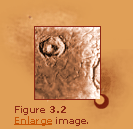|
|

Ejecta Blankets
Compared with the Moon and Mercury, ejecta blankets and fields of secondary
craters are less prominent on Mars. Rayed craters are also rare. However,
the morphology of crater ejecta on Mars is quite unique. Ejecta blankets
of lunar craters are usually blocky near the rim and grade outward with
increasingly more fine grain particles until the blanket merges with the
surrounding area. These features are consistent with the ballistic emplacement
of the ejecta. Many Martian craters, however, have ejecta deposits that
appear to have flowed over the surrounding surface like mudflows.
 |
 |
These craters are known as rampart craters, fluidized craters,
or splash craters. Crater Yuty is a spectacular example of a rampart
crater (Figure 3.2) . The ejecta consist of several relatively
thin sheets with tongue-shaped fronts. It appears that the debris
flowed outward like huge splashes of mud. A ridge was formed at
the front of each ejecta lobe. To the right (or east), the ejecta
seemed to flow uphill onto a degraded rim of an earlier crater.
To the south, a smaller and older crater separated two large lobes,
but was eventually filled with liquefied debris. Liquid water might
have been incorporated into the materials excavated from the crater,
creating a fast moving ejecta mudflow. Water might have been produced
if the ice in the regolith was melted upon impact. (Note that regolith
represents solid materials lying on top of the bedrock, including
soil, rock fragments, and other materials.)
|
< back 1 2
3 next >
|



